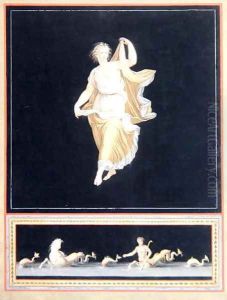Tommaso Piroli Paintings
Tommaso Piroli was an Italian engraver and printmaker, renowned for his fine engravings of classical sculptures and his work based on designs by contemporary artists. Born in 1752 in Rome, Piroli was a key figure in the Neoclassical movement, which sought to revive the styles and subjects of ancient Greek and Roman art. His career flourished in the late 18th and early 19th centuries, a time when there was a surge of interest in classical antiquity.
Piroli's training began under the guidance of the French engraver Joseph-Marie Vien in Rome. He was deeply influenced by the archaeological discoveries of the time, such as those in Pompeii and Herculaneum, which fueled a fascination with the classical world. Piroli's engravings often featured images of ancient artifacts, including vases, reliefs, and statues, contributing to the dissemination of classical styles across Europe.
He collaborated with some of the most prominent artists and cultural figures of his time. One of his most significant partnerships was with the British painter and draftsman John Flaxman. Piroli engraved Flaxman's outline drawings illustrating the works of Homer, Aeschylus, and Dante, which were published in several influential collections. These works are considered some of the finest examples of Neoclassical illustration and contributed to the enduring popularity of Flaxman's designs.
Piroli's meticulous craftsmanship and his ability to capture the essence of classical art made his engravings highly sought after. He created a bridge between the ancient and modern worlds, not only through his artistic practice but also by inspiring a new generation of artists and engravers. His legacy includes a vast body of work that has been influential in the study and appreciation of classical art.
Tommaso Piroli passed away in 1824, leaving behind a legacy that continued to influence artists, historians, and collectors who had an enduring interest in the classical tradition and the art of engraving. His work remains an important resource for those studying Neoclassical art and the reception of classical antiquity in the modern era.
